The Craft of Embroidery by Alison Liley is not a new book. It’s not a fancy book – in fact, it’s just the opposite. It’s a pretty unassuming book, by today’s standards of needlework and craft books.
First published in Great Britain in 1961 and reprinted into the 1970’s, the book is a practical study of the craft of embroidery, intended particularly for the student pursuing the City & Guilds courses and qualifications for hand embroidery, but it also works well for a more general audience – anyone who wants to learn the craft of embroidery.
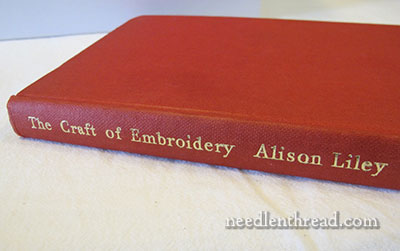
The Craft of Embroidery is available through used book sources, and it’s pretty widely available right now, so you can probably pick it up for $5 – $10 online. There are a variety of different covers for the book – mine happens to have a red library cover, without a dust jacket.
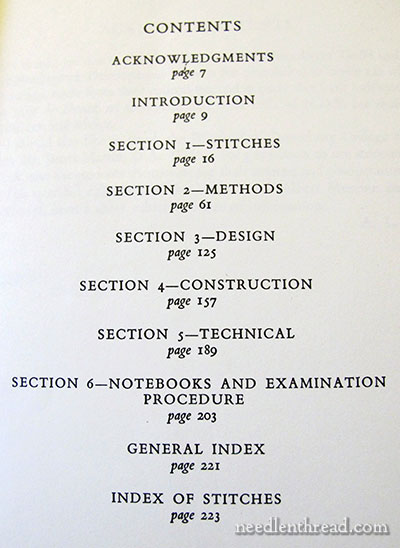
The table of contents clearly lays out what’s in the book. All the basics of the craft of embroidery are covered here.
Craft is an intentionally chosen word for the title, because these are all skills that can be learned by doing.
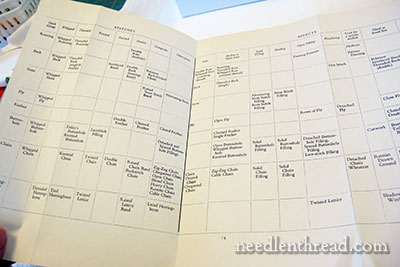
At the beginning of the book, you’ll find a pull out chart that presents basic categories of stitches and their variations, plus effects that can be had with particular stitches in particular categories.
Do you want to create a thick or broad line using a buttonhole type stitch? If you reference the chart, it will tell you which buttonhole variations will accomplish that.

There are plenty of stitch directions in the textbook, all drawn very clearly and explained thoroughly in the text.
Although these aren’t the typical colored diagrams we see today, or the step-by-step colored photos in glossy books, these black and white diagrams work just as well to demonstrate the steps of the stitch.
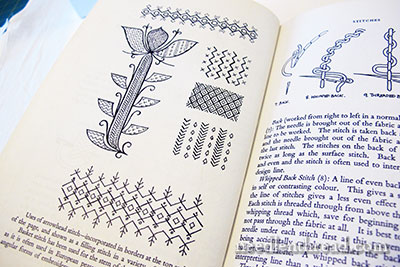
Within the sections on the various stitches, the author also demonstrates how a variety of stitches or variations on a stitch can work together effectively in a design.
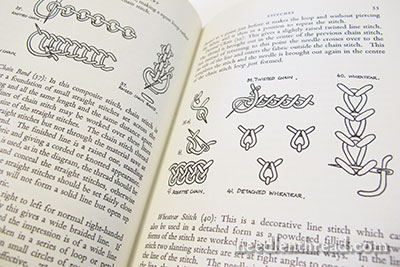
I love the clean, simple diagrams and the well-written text! They cover what needs to be covered, but it’s not spread over pages and pages – it’s all very concise, and very clear.
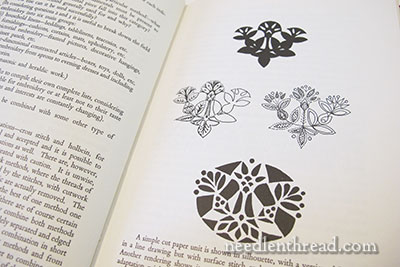
The section on design is informative and instructive as well. Liley covers different aspects of designing, plus all the needful information on how to reproduce designs in efficient ways.
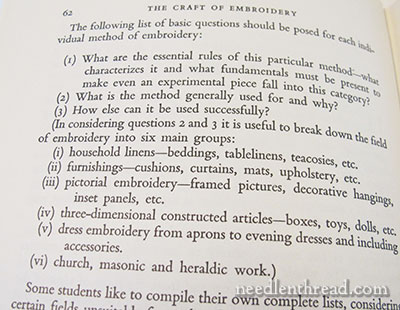
Throughout the book (remembering that this is more of a textbook), there are lists of questions that the student of embroidery should be able to answer. If you’re serious about really learning the craft, it’s a good set-up for self-study.
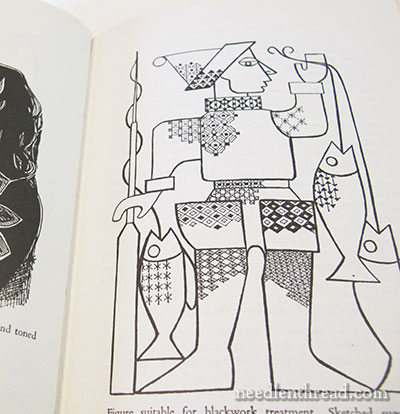
The fellow above illustrates how blackwork fillings can be combined in one design. I think he’s kind of cute!
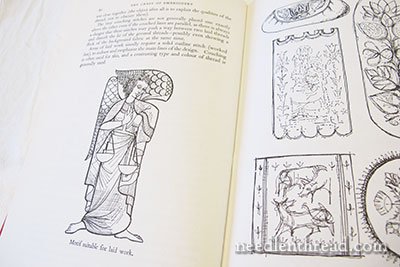
This is more of the design section. The author discusses quite a bit what techniques are suitable for what types of embroidery.
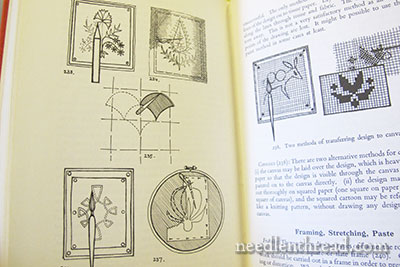
Of course, included in the technical discussion of things, there’s plenty of information on design transferring, setting up embroidery projects, and so forth.
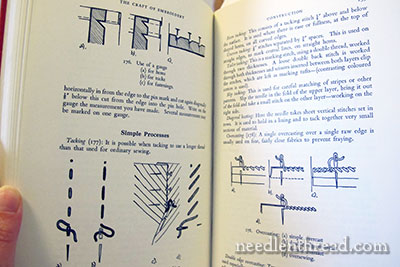
The finishing section covers various ways of finishing embroidered items, beyond just framing. The author also covers laundering and care of embroidered items thoroughly.
The Craft of Embroidery is one of my favorite “old” embroidery books, for general, solid knowledge of the whole craft in a nutshell. It’s an excellent starting place for those who wish to go beyond embroidery as a passing hobby, to learn foundation principles on which a solid pursuit of embroidery as an art can be built.
Lately, I’ve been turning a lot to the old embroidery books on my shelves. They’re so satisfyingly “meaty” – they have such good instructional content in them.
If you want some serious instruction in embroidery, look for these older books in libraries or through used book sources. They may not dazzle you with “eye candy”, but they will help you build a solid foundation in the principles of hand embroidery and embroidery design and execution.
Remember, you can only get so far on a diet of candy, anyway – you need something substantial if you want to be in for the long haul!
What’s your take on older embroidery books? Do you find them more instructive than the books on the market today? Do you have any favorite oldie-but-goody books that you think are a must-have in a needlework library? Any thoughts in general about older books on embroidery and needlework? Have your say below!
*Sigh*
I Love old books…







Dear Mary
I really like old books the smell and the typeface always makes me feel secure and comforted and The Craft of Embroidery seems very informative and I like the reference chart at the beginning and the variation of stitches which are very useful, there seems lots of information on how-to on embroidery in the book. Thanks for sharing this with us.
Regards Anita Simmance
I would buy this book just for the pull-out section alone. Wow, what a treasure. That’s for sharing that, Mary.
thank you for the review on this book-It sounded so good for my libray that I went on amazon and purchased a copy-thank you again Kathy
What a great book. I love books, I especially love old books. The old embroidery books just have something about them that is, as Anita mentioned, comforting. I always love when you share posts about books! And everything else too… ; )
I too love old books but this interesting because it is sooo British…the man in armor is probably not what an American would design…
I have a small collection of “old” Danish Embroidery Guild books that I turn to when I’m looking for playful cross stitch designs with uncomplicated charts!
Hi there! This book looks awesome, but I got side tracked looking up the city and guilds information — is there a way to take it in the United States?
Abbi
I love older embroidery books–back when there were good used bookstores around, I found several great ones. It started with a reprint of the DMC Encyclopedia of Embroidery. My favorite was Mrs. Christies Samplers and Stitches (with diagrams very similar to The Craft of Embroidery). I first found it in a local library and renewed it endlessly (the only time I was tempted not to return a library book!). I subsequently found an older edition. More recently, I got into early 20th Century needlework books. They’re all treasures!
Mary, the book sounds lovely and I almost ordered it for $23.87 until I reflected that I already own a shelf of books on stitches and embroidery. I have been wondering where to draw the line since the more books I invest in, the less money there is for needles, thread, linen, etc. But, like you, I love good books and may, probably will, weaken and order yet another. Thanks for your column and for the excellent review of The Craft of Embroidery.
Where did you find it, Charlotte? I went out to look for it and came up empty!
Hi Mary,
I just love old books too. I enjoyed your book review so much that I ordered a copy. Found a new, unused copy on one of the second hand book sites. Total cost including shipping from the U.K. $35.00. So, anyone interested in a copy, there are several out there.
Joanie
Hi Mary,
My all time favorite used book site is
http://www.ebay.com/sch/slavart/m.html
I have bought dozens of books and always had excellent service, and have found some extraordinary titles.
janetbrandt.com
I have an original copy of this book,Mary, and agree with everything you say about it. I also have her follow-up book, “Embroidery, A Fresh Approach” published in 1964 which deals more with the design side of embroidery but which is almost as good as the first one. Grace.
I have looked every where for the book The Craft of Embroidery and cannot find one. Any advice? I would love to purchase one for myself and another as a gift for an avid embroiderer!
Thank you so much, I love your blog
Thanks for bringing Liley’s book to our attention. It looks like a really good one.
I like the old books and find I turn to them more than the newer ones especially for choosing or mastering an unfamiliar stitch or technique. Some of my favorites are the older Erica Wilson books, particularly her “Embroidery Book” and “Crewel Embroidery”, Marion Nichols’ “Encyclopedia of Embroidery Stitches, Including Crewel”, “The Anchor Manual of Needlework”, and Therese de Dillmont’s “The Complete Encyclopedia of Needlework.” I’m always on the lookout for good old embroidery books at second hand book sales.
Dear Mary,
Wow this is just the type of book I have been looking for. Now I just called a local book store here in Southern Maine, as a rule they can order just about any book, this one they could not find for sale. I checked the book out on several websites that Google suggested. What I discovered is I book dealers from England that sell this good with very high prices and also I could not find this book being sold here in the United States. I have just not searched enough? Thank you for your help. Epona
Your article prompted me to search out my copy of the Encyclopedia of Needlework by Therese de Dillmont put out by DMC.
There is a wealth of information in this small book, including all kinds of embroidery techniques. It also has info on Tatting!, Knitting and Crochet too. She covers most embroidery techniques with good diagrams.
What I do not like apart from its small size, is that the index is not easy to follow. Items are not in alphabetic order. I was looking for Blackwork (one of my passions) and finally found this in the text dealing with linen and it was called Holbein, which of course is one of the names for this technique.
I love receiving your emails. The pictures are real eye candy. Helen.
I like the older embroidery books. For that matter, I also like the older cook books. Had one once that measured by pinch and handful.
Smiles to you.
Linda
I too love older books and have the privilege of housing my EGA Chapter’s library, so I have access to a number of older books from the 1950, 60 and 70’s. I do like some of the newer technique books put out by Country Bumpkin and the Royal School, but the history is interesting in many of the older books, though a number of the ones dating earlier invented their own version of history.
Lynn
Thanks Mary another one for me to purchase and yeah for me I found one with the dust cover. I love the old needlework books and my most recent purchase as of yesterday was a copy of Weldon’s Encyclopedia of Needlework – another absolute treasure.
Mary, this is exactly what I need — so I dashed into Amazon to purchase a copy. Woe is me, there is nothing left, just one seller offering it for $95. I guess your reviews have real power!
Sadly,
Pamela
Yay! *I* found one in the UK also. ARound $24 with shipping. Not many left out there! Thanks for the review,
Pamela
(much happier now!)
I love old books, too. I look at modern books, and all the illustrations they contain, and think that some of illustrations are unnecessary, and would have been better to use that space to tell me exactly what needs to be done. I have “The Complete Encyclopedia of Stitchery” by Mildred Graves Ryan (Doubleday, 1979). It has sections on Crocheting, Embroidering, Knitting, Macrame, Rugmaking, Sewing, Tatting, and a 3 page bibliography. It is mostly descriptions with illustrations in the wide margins.
I found a second-hand book-shop online that had multiple copies of this book so I put it in my favourites to look at during my lunch. 2 hours later, every copy of this book was gone. And now another seller has it available online for $133. Proving the power of the written word…
Hi Mary, thanks, I love reviews of OOP books and will keep an eye out for this one. Though there might not be any left for sale in the world now that you have given it a positive review!
I have lots of ‘oldies’. In terms of general embroidery, Weldon’s Encyclopaedia has so much in it, I love to pick it up and read a chapter any old time. The Stitches of Creative Embroidery by Jacqueline Enthoven is a great instruction book and I also love Embroidery & Needlework by Gladys Fry. I love the Anchor Manual of Needlework for its chapter on Italian embroidery.
Personally I don’t find an overall quality difference between ‘old’ and ‘new’ – no matter what the age, some books have good instructional content and some don’t, some have lovely illustrations and some don’t, some are well-bound and some aren’t.
I have some new books that are very good like “Short and long stitches” by Trish Burr or “Beginner’s guide to goldwork”.
Older books, edited before the end of communism in Poland, sometimes explain stitches better than the new ones.
“My name is Mary Anne and I’m an (embroidery) bookaholic”….off to scour the internet to find a copy that wants to live in my collection.
Me again. Got so excited over the old embroidery book that I forgot to answer your question!! My absolute favourite is ‘Nostalgia Crafts Book’ by Phyllis Fiarotta c 1974. That book was in our local library and I took it out so many times that the library finally took pity on me and gave it to me.
Wow, you must have lovely ‘library ladies’ (or men)! Makes me ‘homesick’ for my old local…
Amazon.co.uk The craft of Embroidery Alison Liley secondhand is £1,988 so I rather think you have a bargain which you should treasure!
I actually prefer the old books to many of the new as there are no distractions from the colour. I learned many stitches (years ago) from Erica Wilson’s Embroidery book, the old version of Mary Thomas’ Book of Embroidery Stitches, Jo Bucher’s Embroidery Stitches and Crewel and the Batsford Encyclopaedia Embroidery Stitches by Anne Butler. I have quite an extensive library of stitch books and the black and white ones would be the last I would wish to part with.
Some are used books and I often think of the person who might have used them before me, hoping they gained as much enjoyment from their needlework as I do.
I LOVE your website, Mary. Thank you for all you show us.
Bonnie
I love little old books, it doesn’t matter what they are, what language they’re in as long as they’re little and old! My daughter recently travelled to Cuba (we’re in Australia), and brought me back a copy of Encyclopedia de Labores De Senora por TH. de Dillmont. Well I loved it so much I tracked down an English copy and it’s perfect. About 6″ tall and published in about 1930. It’s a DMC publication and the illustrations are fantastic. So clear and easy to follow. One funny thing though is it says that if you suffer from damp hands you should keep a little box of ASBESTOS powder in your sewing box to dip your fingers into occasionally!!
Actually, I don’t really mind if a book skips instructional content. I don’t need every single book to illustrate stem stitch or herringbone stitch. If I’ve already got books that cover transfer methods and finishing then I don’t need another one that covers the same techniques. Sometimes it’s useful to have a technique book for a particular type of embroidery, but even those repeat a lot of information.
What I really appreciate are new creative ideas. I think those are inspiring and exciting.
Hi Mary,
I agree with your “candy vs. substance” analogy. Yes, the needlework books on today’s market, look promising on the outside, but they lack substance especially when it comes to technique. It is very hard to master certain technique when only basics are presented. I am finding myself digging into old books too, and also via Internet to other international sources even in languages I don’t understand, trying to figure out at least visuals. I have this problem especially with learning various types of lacework.
Yes, I certainly do love old book! I think you have successfully “sold” all of the copies available of this one with your review! haha! I only found one copy available for over $200!! I’ll keep it on my “list” — although I have many, many, many x 100 books I can use in the meantime! thank you, Mary!
Lantz, Sherlee and Maggie Lane. A Pageant of Pattern for Needlepoint Canvas. New York: Atheneum, 1973. [ISBN 0-689-10571-1]
If I could have only 1 book in my library, this would be it! The diagrams are amazing and the projects inspiring.
I went to my bookshelf and there it was. I purchased it sometime ago from our local used book dealer for $6.00 and barely glanced at it. Mine is a “discard” from the U.S. Army.
Allergies make it best for me to let old books sit for awhile on my shelf before reading. I believe it has properly “ripened” by now so I will read it through. It is a gem!
Elaine in New Mexico
I like the older books. I will admit sometimes it’s difficult to overlook the out-of-date projects and colors and look at the techniques. I have a few of Erica Wilson’s books, reprint and original copies of Therese De Dillmont’s Complete Encyclopedia of Needlework. And others I’m not remembering right now.
It seems that quite a few new books are more simple project and pretty picture oriented. There are some wonderful books that take a narrower but deeper view of embroidery techniques though. My growing list of “want” based on your reviews shows that, Mary.
I have a few books from the 80s(?) that are now well regarded, like Carolyn Ambuter’s The Open Canvas. It will be interesting to see which of today’s books will be sought out in 30 years.
When all else fails I turn to Mary – Mary Thomas’s ‘Dictionary of Embroidery stitches’ that is. I have a reprint copy of the original version (at work). It doesn’t have stitch diagrams showing each or even many steps of each stitch but I just love that simplicity – I can get an overview in a glance and the descriptions and little overview are fabulous. Add to that the funny little drawings throughout – I love it.
I can’t get hold of this book! Which is particularly disappointing as I hope to do the City & Guilds Course in the new year. Not in the UK, nor Amazon USA
No existen palabras para agradecer la generosidad de Mary. Bendiciones !